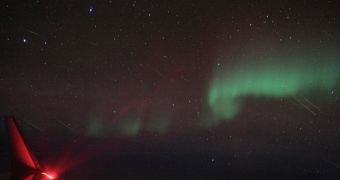Astronomers got an unprecedented view at what is one of the most hard to see annual meteor showers, during the night of January 3rd, with the help of a Gulfstream V aircraft flying over the arctic regions of the Earth. The campaign had been initiated by NASA's Ames Research Center and the SETI Institute, it was called the Quadrantid Multi Instrument Aircraft Campaign, and was comprised of a international team of 14 astronomers.
The privately-own airplane lifted the scientific crew to an altitude of about 14,100 meters in order to get over the cloud top, and flew over the general area of the Arctic Circle. Astronomers that participated in the observation report that the highest meteor rates occurred around 8h UT, much later than previously predicted in the models. The crew implied a flight trajectory that compensated for the rotation of the Earth about its axis, so that they were able to see the meteor shower during the whole span of the mission.
Usually, Quadrantids meteor shower is extremely hard to see from the surface of the planet, mostly because it occurs during the daytime, and suddenly falls under the horizon as the midnight hours approach, reappearing again only in the early hours of the morning. It can last about 8 hours, and the peak rate occurs in the early hours of the morning, when it is capable of outshining even the most brightest of annual meteor showers.
In the QMIAC mission, astronomers were able to count some 846 different meteors streaming through the Earth's atmosphere. Unlike most meteor showers, which are determined by the passing of periodic comets, the Quadrantid shower is caused by a sheet of meteoroids spanning all the way to Jupiter, as its powerful gravitational field routinely acts on the bodies in the asteroid belt, causing them to collide and eject material towards the Earth. This is mainly why the meteor shower is more consistent in some years.
Material density throughout the Quadrantid meteor shower is in direct relation to the age of the stream. It is generally thought that some of the most massive meteoroid streams are no older than 500 years. Chinese history recorded an event about five centuries ago, saying that during a Quandrantid meteor shower a comet was observed moving in the same plane as the meteoroids, which might be evidence that the respective comet was originally the body that determined the appearance of the massive stream.
About five years ago, astronomers discovered that along the meteoroid stream was a minor planet, dubbed 2003 EH1, which could be one of the remnants of a series of breakups that led to the evolution of the stream. A total of 25 cameras have been used during the mission, each with various tasks, such as measuring the light spectrum to determine the composition of the meteoroids, the disintegration of dust particles while streaming through the atmosphere, and fragmentation processes.

 14 DAY TRIAL //
14 DAY TRIAL //